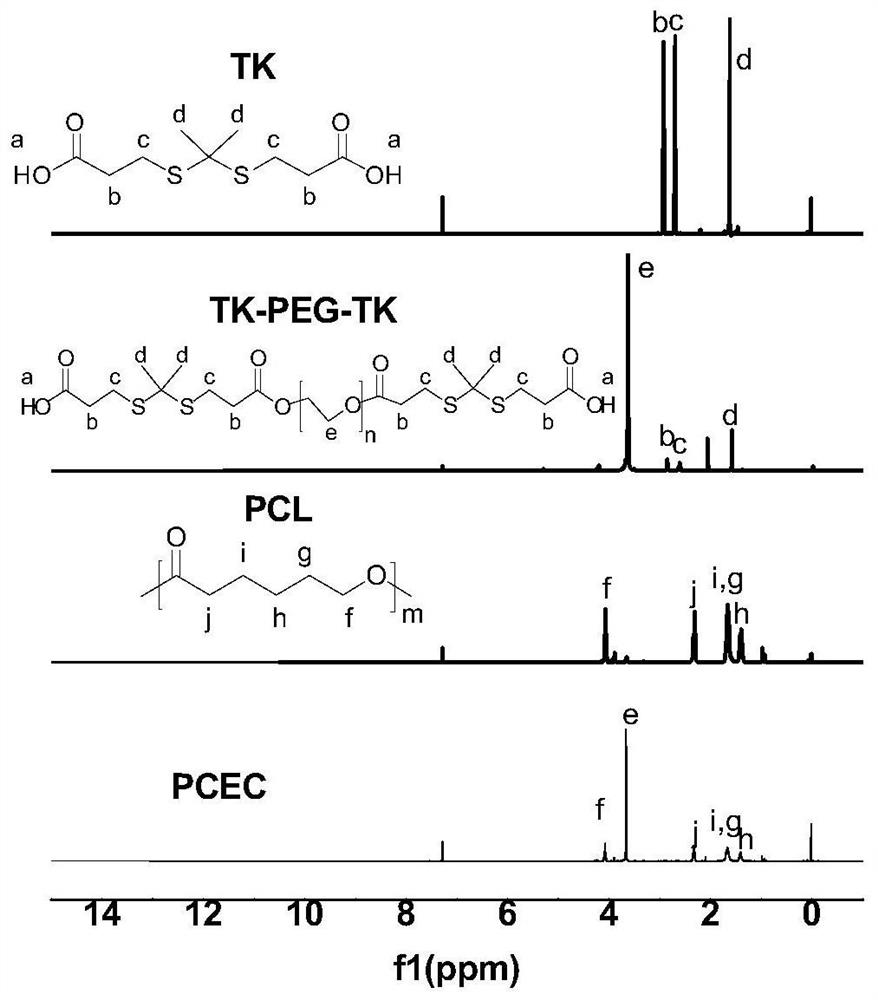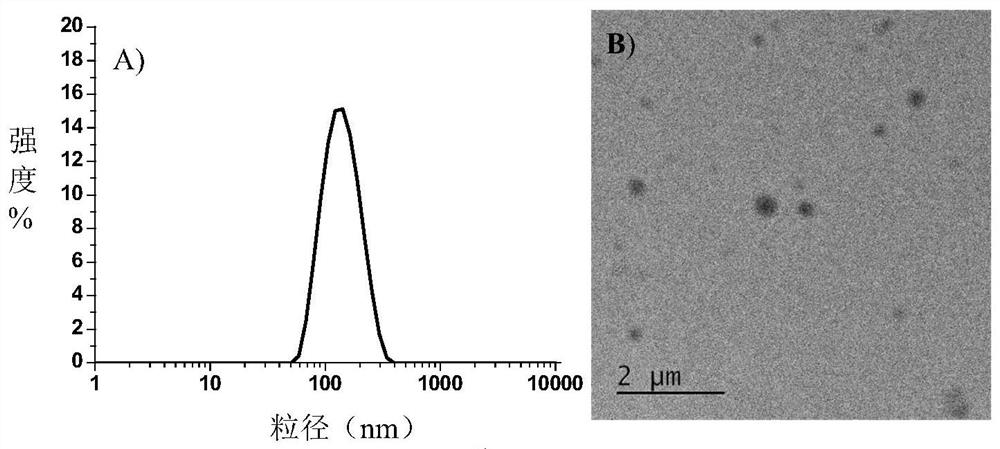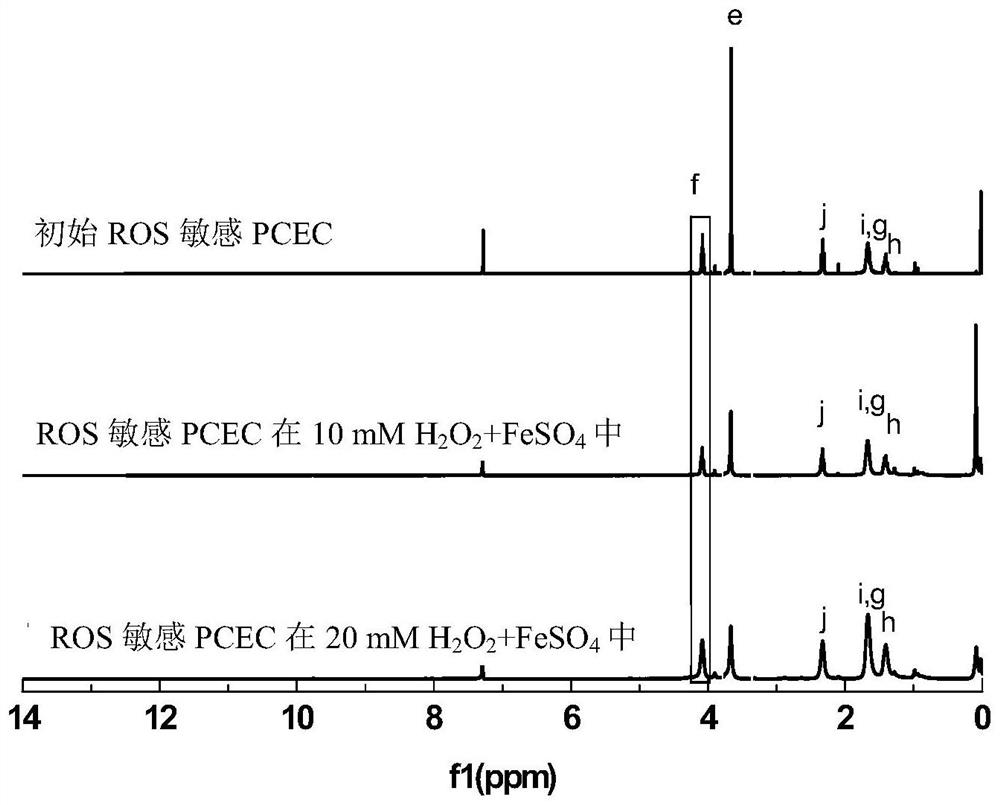ROS-sensitive polyethylene glycol-polyester copolymer nano-drug delivery system and application thereof
A polyethylene glycol and copolymer technology, applied in the field of biomedicine, can solve the problems of short effective time, poor effect, and can only be used by injection, so as to achieve the effect of oral administration
- Summary
- Abstract
- Description
- Claims
- Application Information
AI Technical Summary
Problems solved by technology
Method used
Image
Examples
Embodiment 1
[0032] Embodiment 1 ROS sensitive polymer preparation
[0033] Add thioketal TK (1.0 g) into the reaction flask, and add 3 mL of acetic anhydride to dissolve it, and react at room temperature for 2 hours under nitrogen protection. Then 20 mL of toluene was added to the system, and dried under reduced pressure for 3 times. Add 10 mL of dichloromethane into the reaction bottle, and add polyethylene glycol (3.0 g) with a relative molecular weight of 2000, and react overnight. The product solution was washed 3 times with water, the oil phase was concentrated, and the product was dried. TK-PEG-TK is obtained. In a dry reaction flask, add TK-PEG-TK (1.4g), EDCI (0.55g) and HoBt (0.38g) dissolved in 20mL of dichloromethane, and react for half an hour. Then 1.4 g of polycaprolactone (PCL2000) were added. React at room temperature for 24 hours. The reaction solution was concentrated, dialyzed in distilled water for 24 hours, and the product was freeze-dried for 24 hours to obtain ...
Embodiment 2
[0038] Example 2 (II-1) Preparation of disulfide bond-linked ROS sensitive compounds
[0039] In a dry reaction flask, add cystine (1.0 g), EDCI (0.55 g) and HoBt (0.38 g) dissolved in 20 mL of dichloromethane, and react for half an hour. Add polyethylene glycol (1.0 g) with a relative molecular weight of 2000 into the reaction flask, and add 3 mL of acetic anhydride to dissolve it, and react at room temperature for 2 hours under nitrogen protection. Then 20 mL of toluene was added to the system, and dried under reduced pressure for 3 times. Add 10 mL of dichloromethane into the reaction flask, and add methyl-terminated polyethylene glycol (3.0 g) with a relative molecular weight of 2000, and react overnight. The product solution was washed 3 times with water, the oil phase was concentrated, and the product was dried. Obtain mPEG-TK. In a dry reaction vial, add mPEG-TK (1.4g),
[0040] EDCI (0.55g) and HoBt (0.38g) were dissolved in 20mL of dichloromethane and reacted for ...
Embodiment 3
[0045] The preparation of embodiment 3 drug-loaded nanoparticles
[0046] The polymers prepared in Examples 1-2 above can be combined with various bioactive molecules to form drug-loaded nanoparticles for radiation protection. In the following, only amifostine (Am) and its metabolite WR-1065 are used as examples for illustration.
[0047] The ROS-sensitive polymer self-assembly was prepared by double emulsion (W / O / W) method.
[0048] Drug-loaded nanoparticles 1: Preparation of I-1 / WR-1065 nanoparticles
[0049] Dissolve 50mg of WR-1065 in 200mL of distilled water to form an internal water phase (W1), and dissolve 100mg of I-1 polymer in 2mL of dichloromethane to form an oil phase (O). Add W1 to O and ultrasonicate for 3 minutes in an ice-water bath , forming the first emulsion (W1 / O). Add colostrum into 10 mL of distilled water (W2), and sonicate for 3 minutes in an ice-water bath to form a W1 / O / W2 double emulsion. The dichloromethane was removed by rotary evaporation, and...
PUM
 Login to View More
Login to View More Abstract
Description
Claims
Application Information
 Login to View More
Login to View More - R&D
- Intellectual Property
- Life Sciences
- Materials
- Tech Scout
- Unparalleled Data Quality
- Higher Quality Content
- 60% Fewer Hallucinations
Browse by: Latest US Patents, China's latest patents, Technical Efficacy Thesaurus, Application Domain, Technology Topic, Popular Technical Reports.
© 2025 PatSnap. All rights reserved.Legal|Privacy policy|Modern Slavery Act Transparency Statement|Sitemap|About US| Contact US: help@patsnap.com



